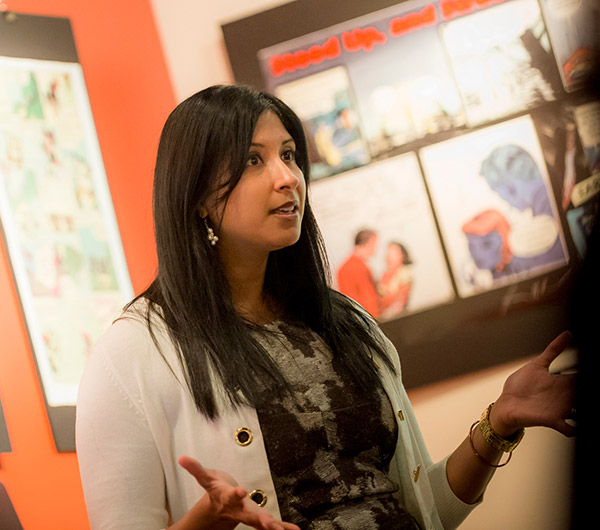
By:
- Christine Clark
Published Date
By:
- Christine Clark
Share This:
Campus Marks World AIDS Day

Photos by Erik Jepsen/UC San Diego Publications
Physician from UC San Diego’s HIV specialty care clinic gives talk on HIV preventive pill
UC San Diego recognized World AIDS Day Dec. 1, embracing the “Getting to Zero” theme to convey the global community effort needed to achieve zero new HIV infections, zero stigma against those living with HIV/AIDS and zero AIDS-related deaths.
This is the third year in a row the campus has marked World AIDS Day with the “Getting to Zero” theme. “We have known for years that this theme, in a number of ways, is a must for us to be effective in the fight against HIV,” said Shaun Travers, director of UC San Diego’s LGBT Resource Center and chair of the World AIDS Day planning committee.

The day included a variety of free and public events, including a viewing of portions of the AIDS Memorial Quilt, which is the largest ongoing community arts project in the world. In conjunction with the theme, the day also featured a talk from Dr. Ankita Kadakia, an HIV/AIDS specialist from UC San Diego’s HIV specialty care clinic, the Owen Clinic. Kadakia gave a presentation about the new once-a-day pill to help prevent HIV infections, Pre-Exposure Prophylaxis (PrEP), which may be the most effective way for people who do not have HIV to prevent HIV infection.
UC San Diego has been on the cutting edge of testing the effectiveness of the PrEP pill (brand name Truvada). In 2012, UC San Diego researchers received a $5.6 million grant to test PrEP’s ability to keep high-risk individuals from becoming infected with HIV.
“PrEP is one of the most promising new ways that we can achieve the goal of stomping out HIV/AIDS, and Kadakia’s presentation is a great way the World AIDS Day theme is being brought to life through research right here at UC San Diego,” Travers said. “This will be the generation that stops HIV/AIDS.”
When the first clinical reports of AIDS emerged more than 30 years ago, those diagnosed with the then-mysterious disease faced a looming death sentence. Most had just months to live. Kadakia explained how much has changed since them. “This is a very exciting time to be in this field,” Kadakia said.
Today, scientists and physicians better understand the pathology of HIV/AIDS and the advent of antiretroviral drugs (prescribed in the early stages of infection) can often render HIV/AIDS a chronic but livable condition. Patients can live relatively normal, full lives for decades after diagnosis and now, for the first time, there is a drug to prevent people from getting infected with HIV.
The PrEP pill contains two medicines (tenofovir and emtricitabine) that are used in combination with other medicines to treat HIV. When someone is exposed to HIV through sex or injection drug use, these medicines can work to keep the virus from establishing a permanent infection.
Kadakia explained how multiple studies followed individuals who were considered high risk for contracting HIV. These subjects, who were followed over the course of multiple years, were prescribed with either a placebo or PrEP and all were given strategies on how best to prevent HIV infection.

Those considered high risk, including the subjects in the PrEP studies, are: individuals who have multiple sex partners without using a condom, persons who are using or recently used intravenous drugs, and people living in areas where there are high levels of HIV/AIDS infection in the population.
The studies ultimately revealed that when taken consistently, on a daily basis, PrEP has been shown to reduce the risk of HIV infection in people who are at high risk by up to 92 percent. PrEP is much less effective if it is not taken consistently.
Kadakia emphasized, the most effective way to prevent HIV infection through sexual intercourse (99 percent) is by using a condom.
“I can’t stress enough the importance of using a condom,” Kadakia said. “PrEP is not a miracle pill. It also cannot stop pregnancy, nor can it prevent the transmission of other sexually transmitted diseases.”
Kadakia explained why the PrEP pill has not been widely distributed in the U.S. yet. “Though, the information on PrEP has been available for years, the medical community is not ‘putting it in the water’ because of concerns over people building a resistance mutation if they developed HIV,” she said. “However, those who are considered high risk for contracting the virus should ask their doctor about the PrEP pill.”
Kadakia says she expects the drug to undergo more studies in the coming years.
“Is PrEP the next step we’re taking toward ending HIV? Possibly,” Kadakia said. “Education is going to continue to be a really important tool in this battle. What I tell my patients is ‘protect yourself. Wear a condom. You can’t protect your partner from getting HIV, but you can protect yourself. It’s the safest method.’”
Share This:
You May Also Like
Stay in the Know
Keep up with all the latest from UC San Diego. Subscribe to the newsletter today.


